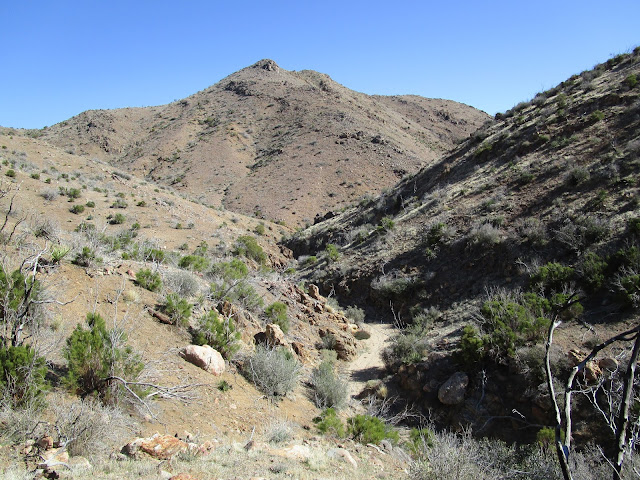Distance: 10.5 miles round trip cross country
Summit Elevation: 5440' (Phil), 5470' (Norte), 5586' (Cody), 4780' (Deering), 4660' (Palm Mesa)
Elevation Gain: 4650'
Elevation Gain (in Empire State Buildings): 3.72
Round trip time: 9 hours 15 minutes
Recommended water: 184 oz.
Parking/Fees: $10 Los Coyotes Reservation (per car day use), parked on San Ignacio Road
Difficulty: Strenuous
Brad and I set out for the Anza-Borrego desert to climb Palm Mesa High Point and pick up several benchmarks and peaks on either side of the canyon along the way. The trailhead starts at the end of San Ignacio Road on the Los Coyotes Reservation. There is a $10 day hike fee for entering the reservation, but when we stopped at the entrance gate, no one was there. We drove on San Ignacio until it turned into a smooth dirt road and followed it until a fallen tree blocked it. We parked there and continued down the road. Our itinerary ended up:
1. Norte BM
2. Phil BM
3. Cody BM (SDC #17)
4. Deering Peak (unofficial)
5. Palm Mesa High Point (SDC #32)
We went past the main wash of the North Fork of Borrego Palm Canyon and entered a side wash below it. We followed that a short distance to a the south ridge of Norte BM. The cross country terrain was not as harsh as the area around San Ysidro or Indianhead, with a notable lack of cholla and other cactus. There were still some obstacles and a potentially disorienting mesh of side canyons. We found the Norte benchmark and register, then made the five minute commute to Phil BM. Phil had a wooden pole marker and register well below the highest boulders. I climbed all the boulders searching for a benchmark with no luck. After a very short break, we continued on to Cody BM, which was a strategic viewpoint. The register was sitting on the benchmark and it was the third time we signed in directly after Eric Su, who completed a giant traverse in December. Both Cody and Pike look somewhat tame from the east, but more like monsters from the lower reaches of the canyon to the west.
We descended sharply off Cody toward the canyon. An eyeball scan of the area led me to believe Deering Peak, an unofficial peak, was actually Palm Mesa. Deering is about 120' higher than Palm Mesa, but it was not nearly far enough down the canyon. Brad didn't question my error and we came up with a strategy to get there by contouring to a less dramatic ridge. We crossed the canyon and sidehilled awkwardly to the ridge where the going got easier. The summit of Deering had a small cairn, but no benchmark or register. I checked in with my GPS to discover that Palm Mesa High Point was a good bit further. We had burned a lot of elevation gain to get to Deering and now would have to give most of it back. We cut our celebration short and plunged down toward the canyon again, looking to preserve as much gain as we could. There were three possible ridges to climb Palm Mesa. We chose the middle ridge as a compromise between the steepest and the longest. Some period of grinding later, just before hitting the top of Palm Mesa, Brad starting getting cramps in both quads. He made it to the top and stretched out, but the cramps didn't let up. We signed the register, ate the rest of our lunch and waited. Fifteen minutes later, we both realized this might be a problem. Palm Mesa is very remote, even by Anza-Borrego standards. There was no cell service and it was at least 4 hours in any direction to the nearest help. I handed him an ibuprofen and a salt tablet and asked if he could make it back. He replied, "I have no choice." We had planned to hit Pike BM on the way out, but it would have to wait for another day. Although he offered, I didn't want to leave Brad to struggle up the canyon while I made the side trip. We made good time to Palm Mesa, but had to slow the pace on the way out. We made frequent stops as his legs kept cramping. Once we got on easier ground, he could sustain longer periods between rests. Topo maps showed a trail heading directly back to the car and we decided to look for it. Except for some scattered remnants, the trail was mostly gone. The direction, though, was true and we eventually lumbered over a hill and down to the car. I'll have to return for Pike BM, maybe doubling up with Hot Springs Mountain, but it was still a successful day -- five summits and no rescue.




















































